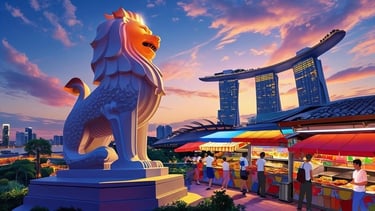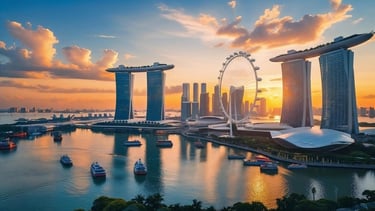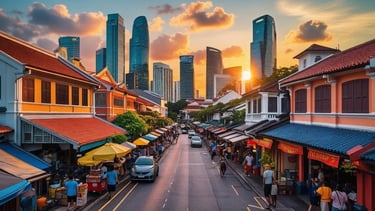Singapore The Country
Singapore's people and culture are defined by a unique blend of Chinese, Malay, Indian, and Western influences, forged from its history as a trading hub and immigrant nation. This multicultural identity is shaped by official government policies promoting harmony and specific core societal values
People and ethnic composition
Singapore's population of over 6 million is highly diverse, with three major ethnic groups and a significant "Other" category that includes Eurasians.
Chinese: The largest ethnic group, making up about three-fourths of the resident population. They descend from various regions of China, including Fujian and Guangdong, and traditionally follow Buddhism, Taoism, and Confucianism.
Malay: Recognized as the indigenous community, comprising about 15% of the resident population. Most are Muslim and have strong ties to the Malay Archipelago.
Indian: The third-largest group at about 7.6%, with a diversity that includes Tamils, Malayalis, and Sikhs. The majority are Hindus, with a portion of the community also adhering to Islam and other religions.
Other: This category, comprising nearly 2% of the population, includes Eurasians and other smaller communities.
Cultural values and social norms
Singaporean society is built on a foundation of group harmony, meritocracy, and strict adherence to laws.
Multicultural harmony: Since independence, the government has prioritized racial and religious harmony through policies like the Ethnic Integration Policy in public housing and celebrating festivals from all major ethnic groups.
Group and family orientation: The concepts of family and group welfare are more important than that of the individual. Respect for elders and hierarchical relationships in families and the workplace are drawn from Confucian values.
Meritocracy and education: Academic and career success is highly valued. The education system is competitive, with good grades seen as a clear path to a better living.
"Kiasu" mindset: A local term meaning "afraid to lose," this mindset reflects a competitive streak in Singaporean culture, motivating people to always strive for the best outcomes.
Rules and orderliness: Singapore is famous for its strict laws designed to maintain a clean and orderly society. This includes fines for littering and jaywalking, and restrictions on chewing gum.
Language and communication
Singapore has four official languages, but the communication landscape is dynamic and diverse.
Official languages: English, Mandarin Chinese, Malay, and Tamil are all official languages. English is the main language of administration, business, and education, while Malay is the national language.
Bilingualism: Most Singaporeans are bilingual, learning English and their mother tongue in school.
"Singlish": An informal, creole language blending English, Malay, and various Chinese dialects, Singlish is widely spoken and seen by many as a marker of national identity.
Communication style: In formal settings, communication is often indirect to avoid causing "loss of face" or personal dignity. Silence is also an important element, indicating thoughtful consideration.
Festivals and holidays
Singapore's calendar is full of public holidays reflecting its multicultural and multi-religious population.
Chinese festivals: Chinese New Year is a major festival with family reunions and vibrant celebrations. Other festivals include the Hungry Ghost Festival and the Mid-Autumn Festival.
Malay festivals: Important festivals include Hari Raya Puasa and Hari Raya Haji, which involve special prayers and family gatherings.
Indian festivals: Diwali (Deepavali), the Festival of Lights, and Thaipusam are significant celebrations for the Indian community.
Other holidays: Other public holidays include Good Friday and Christmas, reflecting the country's Christian population, and National Day on August 9th.
Food culture
Food is a central part of Singaporean culture and a point of national pride, showcasing the country's diverse influences.
Hawker centers: Affordable and delicious food is served at bustling open-air hawker centers, which UNESCO inscribed as an Intangible Cultural Heritage of Humanity in 2020.
Diverse cuisine: The cuisine is a fusion of Chinese, Malay, Indian, and Peranakan (Straits Chinese) flavors. Popular dishes include Hainanese chicken rice, chili crab, laksa, and roti prata.
Culinary pride: For many Singaporeans, eating is a national pastime, and food is a frequent topic of conversation
























Contact Us
© 2025. All rights reserved.
DISCLAIMER
Disclaimer: Advertisements or links appearing on MadeInSingapore.Com do not constitute an endorsement or an approval by MadeInSingapore.com, RENEWABLE ENERGY SOLUTIONS, INC. or their members, officers, or shareholders, of any of the products, services, foods, or opinions of the organization or individual. MadeInSingapore.com, RENEWABLE ENERGY SOLUTIONS, INC. their members, officers, or shareholders, bear no responsibility for the accuracy, legality, or content of the external site or for that of subsequent links.
Disclaimer: Many of the advertisements on MadeInSingapore.com are provided free of charge. MadeInSingapore.com reserves the right to remove any free advertising at any time and without notice.
